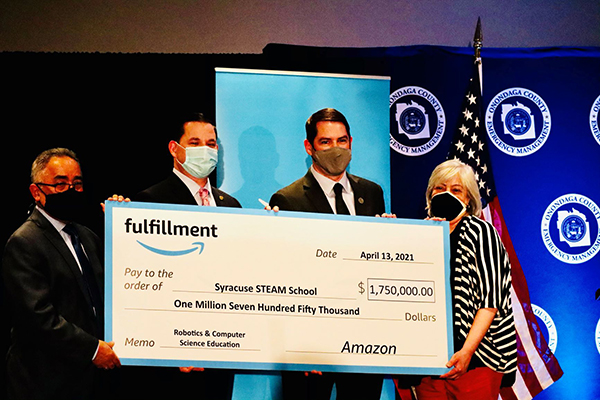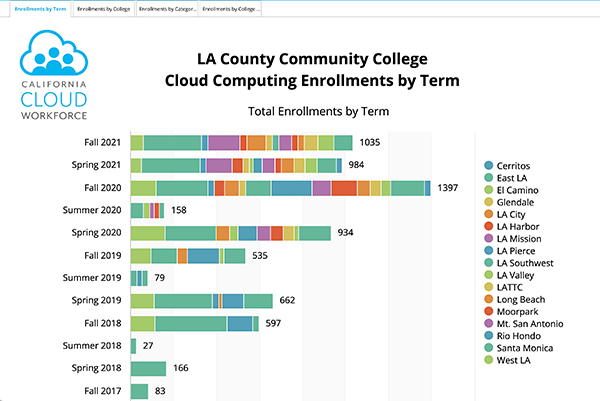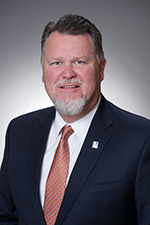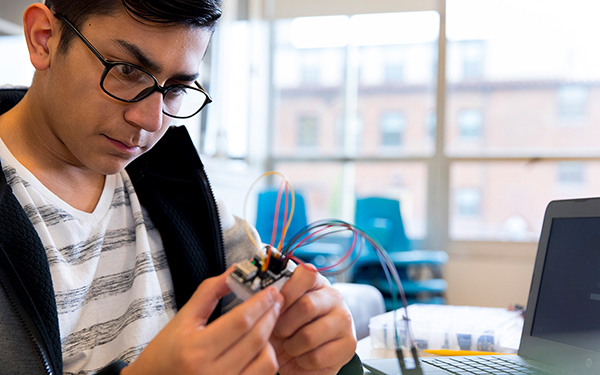Even as state and regional education systems and business coalitions roll out reams of computer, tech and STEM skills certification and boot camp programs, Big Tech behemoths is doing the same. Companies such as Google, Intel, Amazon, Facebook, Microsoft, LinkedIn and beyond have developed their own academic portfolios in order to fill a need for talent that only promises to keep climbing.
Skeptics might point to such programs as community development sops — the sort of philanthropy-tinged outreach a company does to convey its goodwill and commitment to a region even as it hunts out ever more competitive advantage. But there is evidence that the proverbial win-win-win scenario may indeed be unfolding: Companies train people for the positions they and other firms need to fill. Communities build a critical mass of talent. And individual citizens build customized portfolios of certifications and skills.
Briana McClure, an undergraduate computer science student at Georgia State University in Atlanta, is one of those individuals. A past instructor at iD Tech Camps and Google Computer Science Summer Institute participant, she was just chosen as a member of the 2022 cohort of Google interns. “Internships are an important part of my journey,” she told me. “They give me an opportunity to experience the career I wish to go into and help me determine if I chose the correct career path. Additionally, they are a great networking opportunity. Networking and connecting with industry professionals early on helps me overcome some of the invisible barriers that may make it harder to get into the industry.”

Photo courtesy of Intel
Through the Intel AI for Workforce Program, Penny Good and her daughter, Stacy, are enrolled together in an associate’s degree program in artificial intelligence at Maricopa Community College in Arizona. The program, in collaboration with Dell Technologies, is now expanding to 18 institutions that serve a total of 800,000 students, with plans to expand to 50 more community and vocational colleges in 2022.

Fabianna
Rodríguez-Mercado
In New York, Fabianna Rodríguez-Mercado, a young professional from Puerto Rico who is an IT program project management analyst for Accenture and an MBA Candidate at Zicklin School of Business focusing on cybersecurity and technology management., has accumulated her share of stacked network and cybersecurity credentials from CompTIA, Fullstack Academy and La Guardia Community College. But one of her strongest affiliations is Per Scholas, where she now serves as a board member. The non-profit aims to advance economic equity through rigorous, no-cost technical training for tech careers and to connect skilled talent to leading businesses. In February, it will launch its first women-only cohort at its campus in the U.S. capital region, and a new satellite program will see the organization train more than 1,000 New Yorkers in Queens and Staten Island next year. To date, Per Scholas has trained more than 14,000 individuals, backed by funding that in some cases comes from anonymous donors and in others from companies such as Google, Comcast, TD Bank. Among the courses it offers is AWS re/Start, the global upskilling program recently expanded by Amazon from 25 to 98 global cities. Amazon has been an integral partner of Per Scholas since 2020 across several campuses, and has hired 89 Per Scholas graduates to pursue careers in its own ranks.
“When I was looking for opportunities to start in IT, I was looking for a program that could offer me different things, including not getting into debt before having the opportunity to test the market,” Rodríguez-Mercado says. “A friend mentioned Per Scholas, and that was my first step into an IT career.” While other programs left cold, opportunistic impressions (click, click, click … here’s your certificate), Per Scholas was different. “They were looking to build a community of people wanting to build careers in technology.” While she has encountered conflicts between potential employer statements and actions when it comes to requiring degrees, overall, she says, “I think these certifications and training programs are effective.”
According to the Cyberstates 2021 report from CompTIA, even as some sectors remain decimated by the pandemic, cloud computing and other tech jobs keep expanding, from cybersecurity and data science to software development and quality assurance, web developers and digital interface designers, IT managers and database administrators and architects. It’s estimated there are currently some 400,000 computing job openings in the nation. There are currently about 5.2 million jobs in IT with an expected increase of at least 15% over the 2020-2030 period – much faster growth than for other industries.
Cybersecurity employment in particular is expected to increase by 31% through the next decade. And IT employees earn a median wage of almost $86,900 per year, 89% higher than the national median wage. “This is true even for middle-skill employees with less than a bachelor’s degree,” says a fact sheet from Advance CTE based on BLS and CompTIA data. “For instance, web developers and digital designers with an associate degree can earn $77,200 annually, and computer network support specialists educated at the same level can earn about $65,500.”

In April Amazon donated $1.75 million to construct a new STEAM (Science, Technology, Engineering, Arts, and Math) high school in Onondaga County, New York, not far from where it’s ramping up a new 1,000-job robotics fulfillment center.
More Than a Store
Within the small club of Big Tech, Amazon’s menu of CTE, apprenticeships, internships, externships and other initiatives stands out. Even as the daily media narrative characterizes the company as an ogre or bully, individuals wanting to further their careers might see a gentler giant giving them a leg up.
On that menu are such programs as Amazon Future Engineer, AWS Academy and the company’s Career Choice upskilling benefit whereby, for eligible employees, Amazon will pay up to 95% of tuition and fees towards a certificate or diploma across 20 qualified fields of study, from nurse to network technician to trucker to aircraft mechanic. As of October 2020, the company had invested more than $60 million in the program and engaged 30,000 employees, all part of its stated 2019 commitment to invest $700 million and train 100,000 Amazon employees in the U.S. for high-demand jobs. On top of that, Amazon Web Services (AWS) pledged to provide free cloud computing skills training to 29 million people worldwide. That’s 29 million individuals, not counting the millions reached through the company’s educational institution partnerships.
Having already reached 6 million with its free cloud computing training courses, Amazon in November announced four new initiatives to help reach its goal: AWS Skill Builder (a new digital learning experience), the addition of AWS courses to the Amazon.com website, the expansion of the AWS re/Start global reskilling program from 25 global cities to 98 cities, and the opening of the AWS Skills Center in Seattle — Amazon’s first dedicated, in-person cloud learning space, with more such centers to come.
The company’s technical skills partnerships are not limited to the U.S. AWS cloud computing education agreements were recently hatched with the University of Bahrain, three CEU universities in Spain and Swinburne University in Australia. The University of Bahrain will migrate its entire IT infrastructure to AWS, after starting first with extensive workforce training and development for its own staff.
In February 2021, more than 1,000 full-time Amazon apprenticeships across 25 different occupational fields were being offered in the East Midlands in the UK, where the company operates a major fulfillment center in Kegworth. The company created 10,000 new permanent jobs in the UK in 2020. A total of 100 degree-level apprenticeships were available in automation engineering, project management, software development and chartered management.
The company doesn’t ignore K-12 either. In April it donated $1.75 million to construct a new STEAM (Science, Technology, Engineering, Arts, and Math) high school in Onondaga County, New York, not far from where it’s ramping up a new 1,000-job robotics fulfillment center. Two schools in Onondaga County also participate in the Amazon Future Engineer program, which earlier in the year donated $15 million to Code.org to support the development and launch of a new equity-minded Advanced Placement computer science programming curriculum. According to a release, state education leaders in Georgia, New Mexico, Ohio, Oklahoma, and Pennsylvania have pledged to expand AP CSA during the 2021-2022 school year.
In the U.S., the company has partnered with such institutions as Northern Virginia Community College and several HBCUs, most notably Howard University, which in May 2021 announced that the partnership would help it launch a master’s degree in data science in 2022, offer cloud and other training to faculty and even teach cloud computing at the Howard Middle School of Math and Science on its campus. In June, a collaborative initiative among AWS, the Technical College System of Georgia (TCSG), the Georgia Department of Education (GADOE) and the Technology Association of Georgia (TAG) was launched to provide cloud computing training and education to 5,500 learners statewide by 2024.
“We have a goal to certify 1,200 K-12 students across our state in cloud computing, giving them a pathway to a career in this thriving industry,” said Georgia State School Superintendent Richard Woods. Similar state programs are under way with Utah and Arizona, among others, with the goal of reaching 5,000 students in each state by 2022.
Each state has a different need to solve for, says Kim Majerus, leader, U.S. education and state & local government at AWS. But they all want to keep citizens and taxpayers within state boundaries. “To do that they have to create programs to raise the bar on the talent they have,” she says, “to upskill and reskill so companies want to come to their state.”
‘Continue Your Journey’
AWS and Amazon educational partnerships seem nearly as ubiquitous as its facilities. But it’s the individual connections that are — much like an Amazon customer’s purchase history —expanding exponentially
“Literally thousands of students trained in AWS,” reports Howard A. Stahl, professor and department chair in the Computer Science & Information Systems department chair at Santa Monica College. “Hundreds passing industry certification exams. Numerous industry partners offering internships to our students. Many students have been hired in the field, earning great wages.”
Stahl championed the program at the college and has worked to scale it across 19 colleges in the Los Angeles area that are now the California Cloud Computing Workforce Project. Numbers shared with me in November 2021 showed 6,657 cloud computing enrollments at 17 of those schools since fall 2017, more than half of them occurring since the fall 2020 semester.

Graphic courtesy of Santa Monica College
Majerus says Santa Monica College and Carnegie Mellon University were early adopters after AWS Educate launched in 2015. AWS Academy and AWS re/Start came next, all aimed toward building the next-generation workforce, she says. For those moving toward a four-year degree, the programs help to place technology as the foundation of a curriculum, she says, “but many of us are mid-career and looking for a change. There’s where the programs have made such an impact. We’re meeting people where they’re at. We have hundreds of courses delivered in different formats, from 10 minutes to two hours to full-time intensive training options. You pick what you need, and you continue your journey.”
Majerus highlights the experience of one student, Michael Brown, who started taking cloud courses at Santa Monica College, moved on to Arizona State University and finished his studies at Western Governors University before taking a DevOps role at LexisNexis. Another relocated to Florida from Puerto Rico after a hurricane, joined AWS Educate, completed the company’s cloud career pathways training and then joined Universal Studios as a full-stack developer. “AWS has kind of given me superpowers in a way,” he has said. “That core basis of passion underpinned by strong technical capabilities makes a big difference,” Majerus says.
Cloud capabilities were paramount when the pandemic struck and her clients in state and local government had to quickly adjust from legacy systems to cloud-based systems. She cites Rhode Island, West Virginia and Ohio among the states that would have struggled because of legacy tech’s limitations if they had not had staff with skills to use the cloud in an agile environment. “One staff had a center up and running in four hours,” she says. School systems likewise had to adjust overnight, with cloud skills helping systems such as the Los Angeles Unified School District quickly set up support systems for teachers and students in English and Spanish.
Two Respected Perspectives
Leaders at two community college systems in Louisiana and Virginia with years of experience working with AWS offer unique insights into why and how it works.
Steve Partridge, vice president of workforce & economic development at Northern Virginia Community College, may know Amazon’s programs better than most, as the company pursues its massive employment goals for the legendary HQ2 campus taking shape in his region. The push comes as NoVa examines how to “deconstruct the degree,” he says, and make credentials stackable. He says the IT field was relatively sleepy until HQ2’s arrival made it the fastest-growing field. NoVa’s neighborhood has the highest concentration of tech jobs in the nation, and second highest in cybersecurity in particular.

“The program was built with the student in mind, allowing for flexible course delivery and maximizing the earn-while-you-learn principles that are proven effective.” — Dr. Monty Sullivan, President, Louisiana Community and Technical College System, on working with AWS
“Our companies can’t get enough people,” he says. “They’re all waiting at the end of the pipeline for the same people.” Even as bachelor’s degree requirements, long used as weeding-out tools, cling like barnacles to 90% of IT job openings in northern Virginia, Partridge says, “Google and Facebook say, ‘The bachelor’s degree is less of an issue now for us. I need someone who can code. I need someone with an AWS certification.’ ” Removing that bachelor’s requirement can also help those same companies achieve new diversity and equity goals — even as their own programs seek to help those same populations achieve such degrees as part of their longer-range career development.
When Amazon first approached NoVa about an apprenticeship program, “we were a little leery,” Partridge says. “We don’t want to do this with just one company. We looked around, and found about 400 companies that need this. So evenif the relationship with Amazon falls apart, they could find jobs. And we have skin in the game from both partners. If you want us to create something special, there needs to be some skin in the game both ways.”
Amazon is all in. While it’s busy delivering more than 4 billion packages a year, it wants to deliver tens of millions of skilled professionals too.
“Amazon wants to make sure people have access to the skills and learning they need in order to be a part of that workforce of the future,” says Majerus.
Louisiana Community and Technical College System President Dr. Monty Sullivan says the partnership between AWS and his system’s 12 colleges was a game-changer in multiple ways.
“First, we did not take lightly the development and co-branding of a degree program in web services with Amazon,” he tells me. “We recognized from the start that most of our graduates would be working right here in Louisiana but not only for Amazon. The vast majority will go to work for companies of nearly every sector, reflective of the expansion of web services and the broader workforce needs. That point is what led the LCTCS to launch this degree program at all 12 colleges.”
Some of the program’s first graduates are from the state’s most rural communities, “reinforcing the fact that many of these jobs can be done from anywhere broadband is available,” Sullivan says. “This kind of program should reignite all of our interest in the largely untapped potential of the rural workforce.”
Sullivan emphasizes that “the impact for students is real. First, the program was built with the student in mind, allowing for flexible course delivery and maximizing the earn-while-you-learn principles that are proven effective. The students who have already completed the program report a very strong job market and strong earning potential. We look forward to seeing the full employment and earnings report for this program in the months ahead.”
More broadly, the experience of partnering with a major partner like Amazon, convening faculty to develop the program and now seeing the results has caused the entire LCTCS system to focus even more, Sullivan says, on the importance of business partnerships and the need to move forward as a collection of colleges to meet the workforce needs of Louisiana.
“For many years in higher education we have focused on our degrees or certificates as our product,” he says. “More and more, we are learning that there are other dimensions to our product line including an incredible faculty and leveraged business partnerships that benefit the student in many ways. The AWS partnership is a classic example of just that principle.”

Photo courtesy of Microsoft
Microsoft in September 2021 announced that its Technology Education and Literacy in Schools (TEALS) program was expanding into Mexico for the first time via partnerships with four schools in Juarez. It marks the first time the TEALS curriculum has been available in Spanish. The program, which pairs technical volunteers from industry with curriculum and teachers to bring computer science education to underserved students, taught coding skills to more than 93,000 students over its 12 years in existence. The program operates in 31 states, Washington, D.C., and British Columbia with the involvement of more than 700 companies and 1,650 volunteers, including programs at 23 schools across the Rio Grande River from Juarez in El Paso, Texas.
The Juarez news came one year after the company announced in collaboration with the Texas Education Agency that its Accelerate initiative, designed to address economic recovery through skilling both underserved communities and re-skilling Americans impacted by COVID-19, would expand into Texas (pictured). Accelerate was part of the company’s larger Global Skills Initiative to help 25 million people worldwide acquire new digital skills by the end of 2020.
Microsoft says 58% of all new STEM-related jobs are in computing, but just 10% of STEM graduates are in computer science. “It’s estimated there are currently 400,000 computing job openings, with roles available in every state,” the company said. “This demand is expected to grow at twice the rate of all other jobs.”
This story was produced as part of the Higher Education Media Fellowship at the Institute for Citizens & Scholars. The fellowship supports new reporting into issues related to post-secondary career and technical education. For more information, visit citizensandscholars.org.

